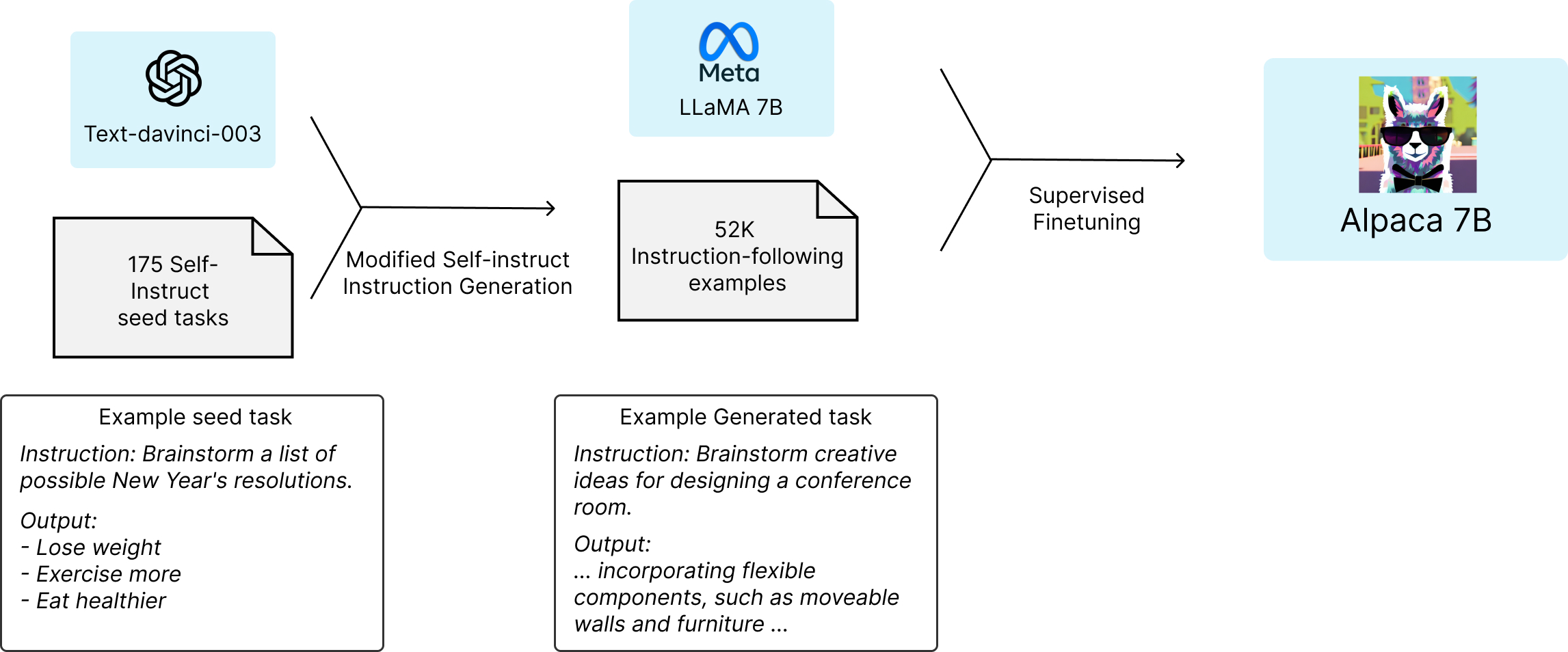Alpaca
YouTube ... Quora ...Google search ...Google News ...Bing News
- Alpaca | Stanford
- Alpaca | R. Taori, I. Gulrajani. T. Zhang, Y. Dubois, X. Li, C. Guestrin, P. Liang, & T. Hashimoto A Strong, Replicable Instruction-Following Model
- LLaMA | Meta
- Large Language Model (LLM) ... Natural Language Processing (NLP) ...Generation ... Classification ... Understanding ... Translation ... Tools & Services
- Large Language Model (LLM) Ecosystem Explained
- Artificial Intelligence (AI) ... Generative AI ... Machine Learning (ML) ... Deep Learning ... Neural Network ... Reinforcement ... Learning Techniques
- Conversational AI ... ChatGPT | OpenAI ... Bing/Copilot | Microsoft ... Gemini | Google ... Claude | Anthropic ... Perplexity ... You ... phind ... Ernie | Baidu
- Agents ... Robotic Process Automation ... Assistants ... Personal Companions ... Productivity ... Email ... Negotiation ... LangChain
- Analytics ... Visualization ... Graphical Tools ... Diagrams & Business Analysis ... Requirements ... Loop ... Bayes ... Network Pattern
- Development ... Notebooks ... AI Pair Programming ... Codeless ... Hugging Face ... AIOps/MLOps ... AIaaS/MLaaS
Researchers at Stanford University have taken down their short-lived chatbot that harnessed Meta’s LLaMA AI, nicknamed Alpaca AI. The researchers launched Alpaca with a public demo anyone could try last week, but quickly took the model offline thanks to rising costs, safety concerns, and “hallucinations,” which is the word the AI community has settled on for when a chatbot confidently states misinformation, dreaming up a fact that doesn’t exist. - Stanford Researchers Take Down Alpaca AI Due to 'Hallucinations' and Rising Costs - Thomas Germain - Gizmodo
Not only does this model run on modest hardware, but it can even be retrained on a modest budget to fine-tune it for new use cases. Using their methods, the team showed it was possible to retrain their LLM for less than $600. Alpaca: The Large Language Model That Won't Fleece You | Nick Bild - Hackster.io ... Alpaca builds on LLaMA to make large language models more accessible, demonstrating that they can be retrained for new uses for under $600.
Fine-tuning is a process of adjusting the parameters of a pre-trained model to improve its performance on a specific task. In the case of Alpaca, fine-tuning can be used to improve its performance on a variety of tasks, such as:
- Generating text in a specific style or genre
- Translating languages more accurately
- Answering questions more comprehensively
- Writing different kinds of creative content
To fine-tune Alpaca, you will need a dataset of text and code that is relevant to the task you want to improve. The dataset should be large enough to provide the model with enough data to learn from.
Once you have a dataset, you can use a fine-tuning framework, such as Hugging Face Transformers, to fine-tune the Alpaca model. The fine-tuning process typically involves adjusting the model's parameters using a technique called backpropagation.
The amount of time it takes to fine-tune Alpaca depends on the size of the dataset and the complexity of the task. In general, fine-tuning Alpaca can take several hours to several days.
The results of fine-tuning Alpaca can vary depending on the dataset and the task. In some cases, fine-tuning can significantly improve the model's performance. In other cases, the improvement may be more modest.
Overall, fine-tuning is a powerful technique that can be used to improve the performance of Alpaca on a variety of tasks. If you are interested in fine-tuning Alpaca, there are a number of resources available online, including tutorials and pre-trained models.
Here are some additional resources that you may find helpful:
- Fine-tuning Alpaca with LoRA
- Fine-tuning Alpaca and LLaMA: Training on a Custom Dataset:
- Fine-Tuning Llama-2: A Comprehensive Case Study:
